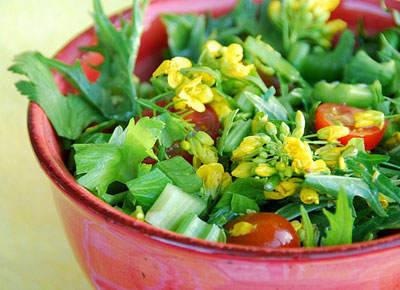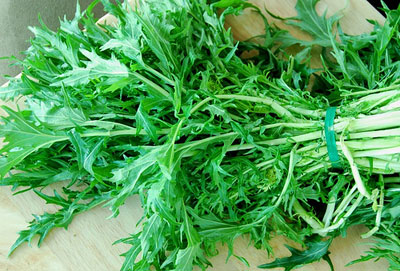 Growing up "salad" meant a plate with iceberg lettuce, cucumber, carrot, and tomato slices, and bottled Catalina dressing.
Growing up "salad" meant a plate with iceberg lettuce, cucumber, carrot, and tomato slices, and bottled Catalina dressing.
Like TV's, salads have come a long way since then.
I remember in the 80's everyone started eating Caesar salad, and romaine bumped iceberg as the lettuce of choice. Then sometime in the '90s peppery salad leaves like arugula and radicchio were clandestinely added to salad plates. Back then people would disparagingly call them "the lettuce that bites you back." Ah, how things have changed.
Then came mesclun, and salad was never the same. Mesculn is a mix of tender, young salad leaves. Its name comes from the French mescla meaning "to mix." Mesclun varies depending on the source but may include arugula, mustard greens, oak leaf, radicchio, red beet greens, and sorrel.
The first time Jeff and I ate fresh mesclun from the farmers' market here in California we were taken aback:
"Wow! This salad has lots of flavor. You can really taste the greens," Jeff said.
Talking right over him, I exclaimed, "Is that a baby beet green?"
 "Do you have these green pointy things in yours?" he replied, ignoring my question, "They're fantastic!" (Yes, we do get this excited over salad at my house.)
"Do you have these green pointy things in yours?" he replied, ignoring my question, "They're fantastic!" (Yes, we do get this excited over salad at my house.)
Turns out those green pointy things were mizuna. Mizuna is a Japanese mustard green with dark green, thin, serrated leaves, and a pleasantly spicy, peppery flavor. Though it has been cultivated in Japan since ancient times, it is believed to have originated in China. Most recipes for mizuna are Asian, and it features prominently in salads, soups, and stir-fries. It can be eaten raw or cooked, and it is packed with nutrients such as carotenes, folic acid, and vitamin C.
Mizuna is available at markets such as Whole Foods, and if you buy Trader Joe's herb salad mix, it's in there too. So you may have been eating mizuna without even realizing it.
Just when you thought you couldn't take any more salad excitement, I have to mention broccoli flowers. These tiny, yellow edible flowers have a robust flavor and beautify any salad. If you find them, don't hesitate to get them.
Mizuna and Broccoli Flower Salad
Serves 4
Salad:
6-8 cups mizuna**
3-4 inner white stalks of celery with the leaves, thinly sliced on the diagonal
10-12 cherry or grape tomatoes, sliced in half
a handful of broccoli flowers, optional
Dressing:
1 tablespoon extra virgin olive oil
1 tablespoon rice wine vinegar
1 tablespoon fresh lime juice
1 tablespoon honey
the zest of 1/2 lime
6-8 cranks freshly ground black pepper
salt, to taste
Wash and pat dry the mizuna and place in a large bowl; add celery and tomatoes.
To make the dressing, whisk all ingredients in a small bowl. Add to salad; toss well to coat, then sprinkle with broccoli flowers, if using.
**Mizuna substitutions to consider: watercress, wild arugula, tender baby kale or mustard greens, tatsoi (another spicy Asian green that is usually available in markets such as Whole Foods.)
Susan Russo is a free lance food writer in San Diego, California. She publishes stories, recipes, and photos on her cooking blog, <Food Blogga and is a regular contributor to NPR’s <Kitchen Window. She is also the author of Recipes Every Man Should Know and The Encyclopedia of Sandwiches
.

